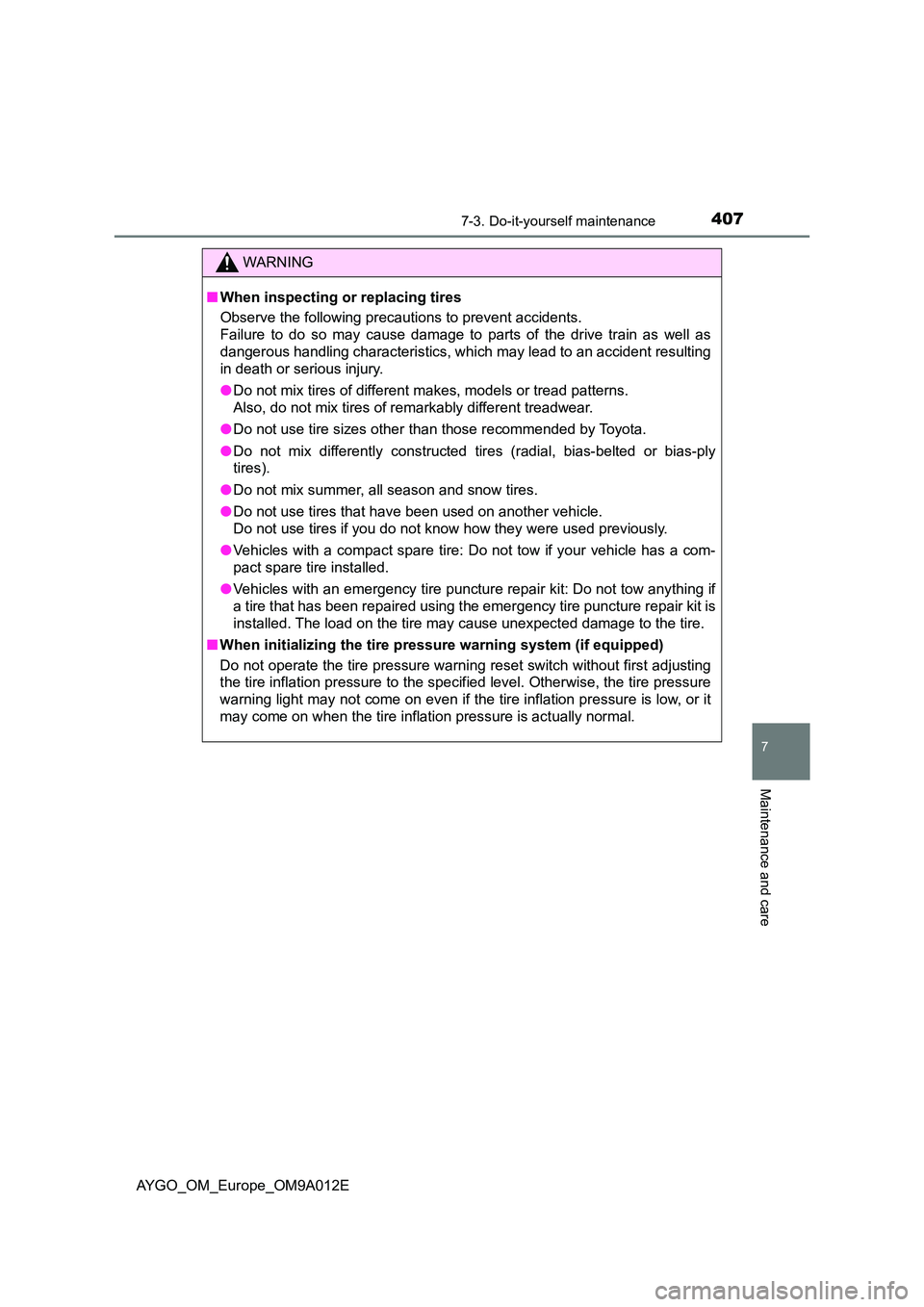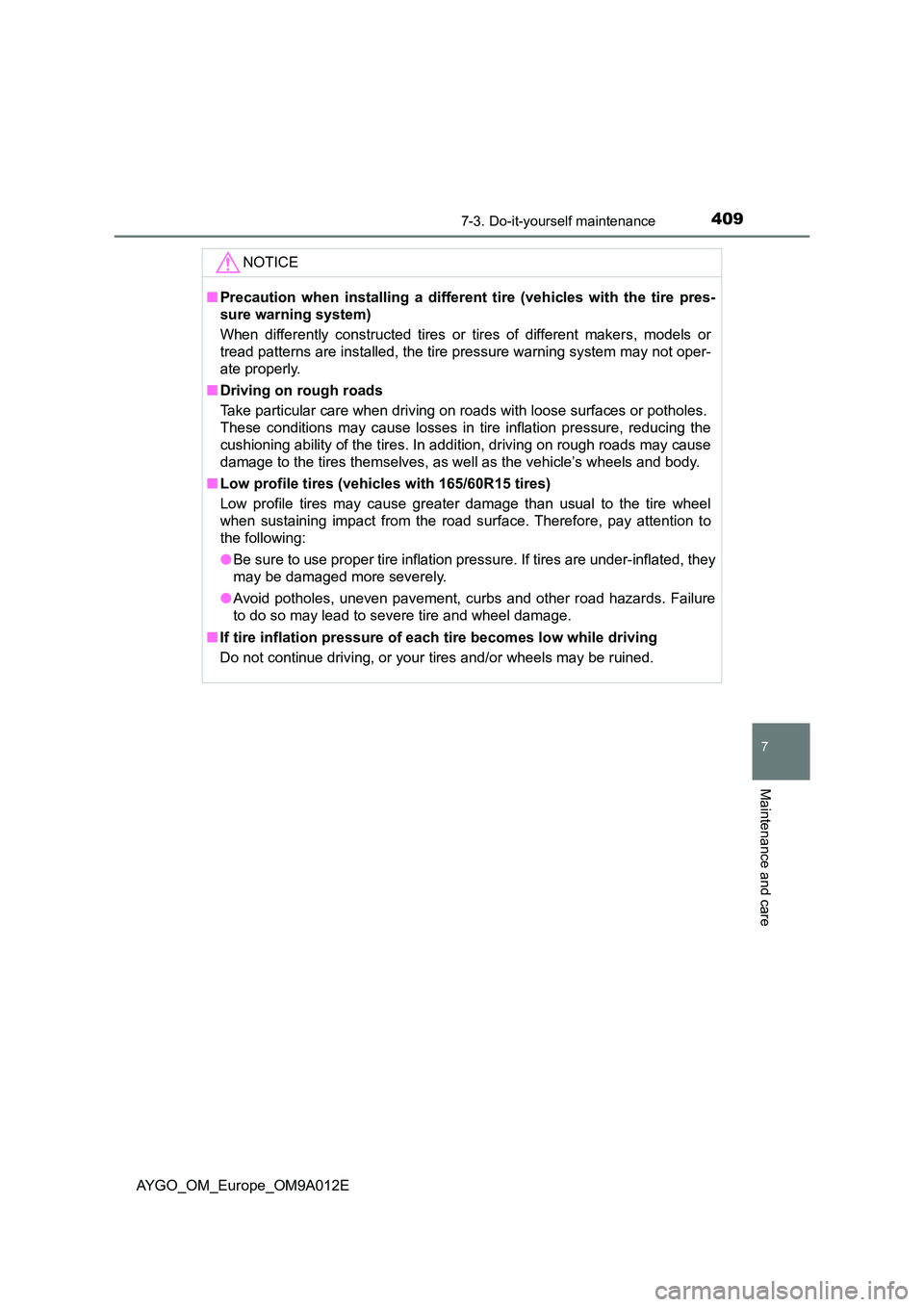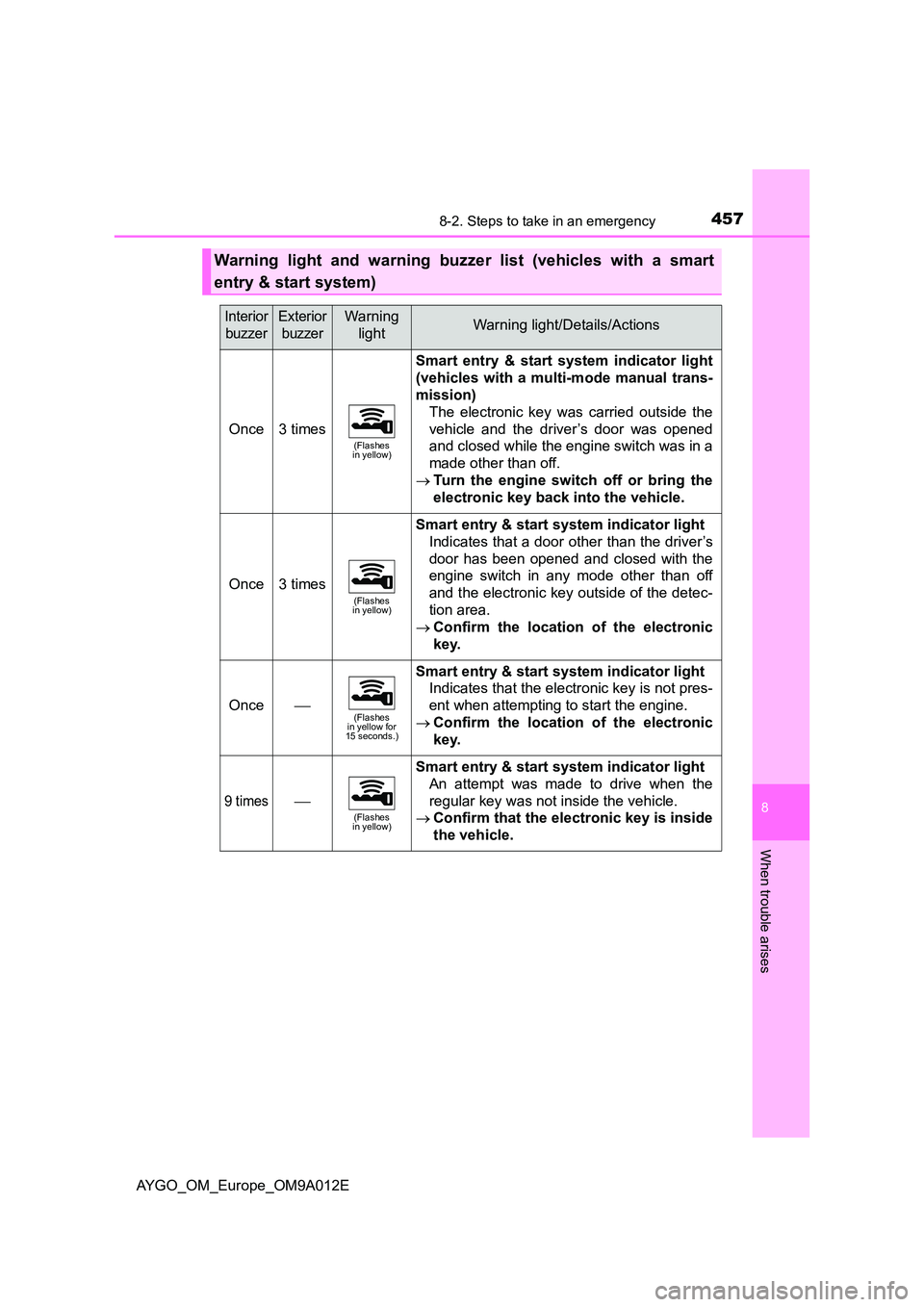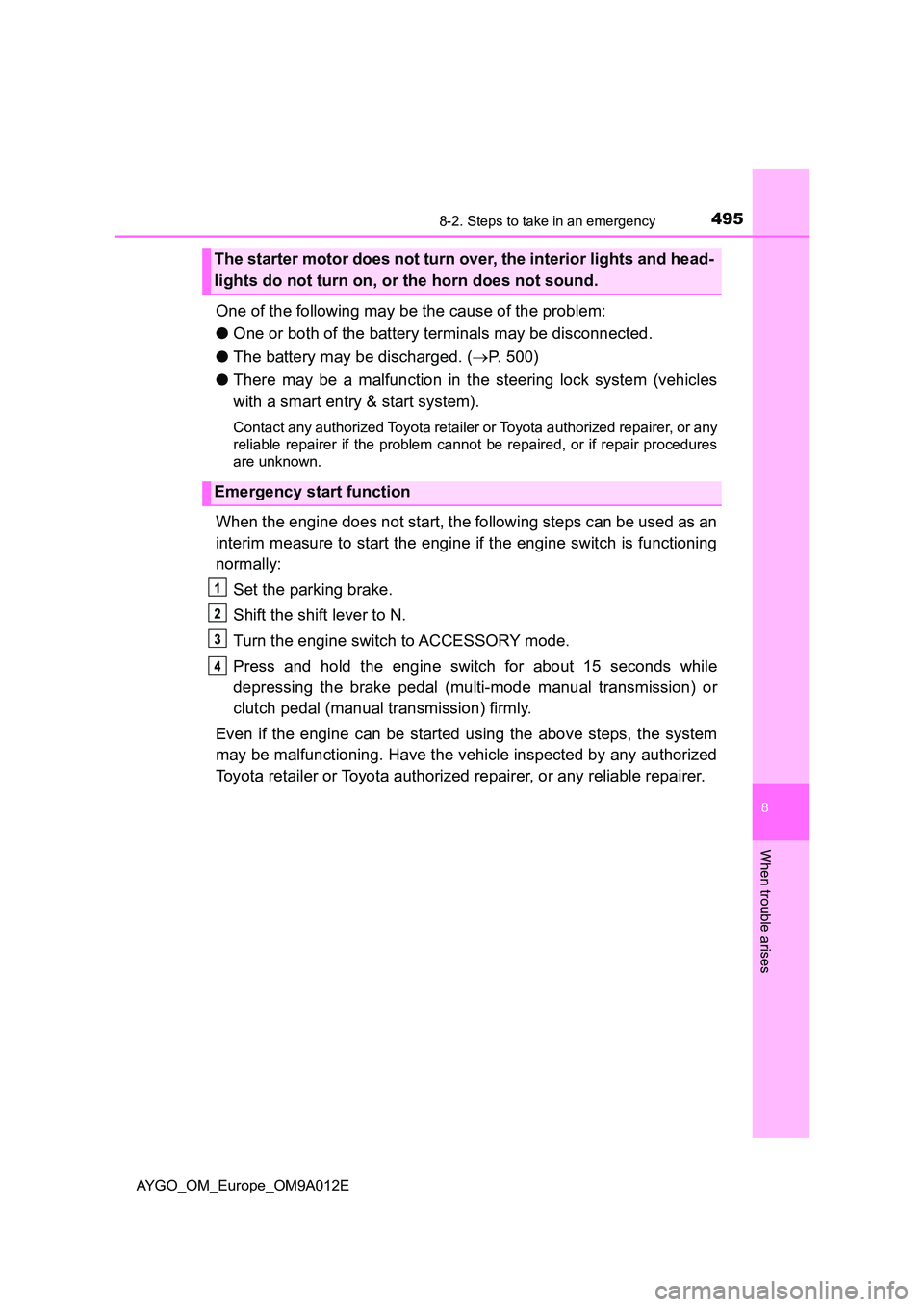2021 TOYOTA AYGO ECO mode
[x] Cancel search: ECO modePage 402 of 546

4007-3. Do-it-yourself maintenance
AYGO_OM_Europe_OM9A012E
■Before recharging
When recharging, the battery produces hydrogen gas which is flammable and
explosive. Therefore, before recharging:
●If recharging with the battery installed on the vehicle, be sure to disconnect
the ground cable.
●Make sure the power switch on the charger is off when connecting and dis-
connecting the charger cables to the battery.
■After recharging/reconnecting the battery (vehicles with a smart entry &
start system)
The engine may not start. Follow the procedure below to initialize the system.
Depress the brake pedal with the shift lever in N.
Open and close any of the doors.
Restart the engine.
●Unlocking the doors using the smart entry & start system may not be possi-
ble immediately after reconnecting the battery. If this happens, use the wire-
less remote control or the mechanical key to lock/unlock the doors.
●Start the engine with the engine switch in ACCESSORY mode. The engine
may not start with the engine switch turned off. However, the engine will
operate normally from the second attempt.
●The engine switch mode is recorded by the vehicle. If the battery is recon-
nected, the vehicle will return the engine switch mode to the status it was in
before the battery was disconnected. Make sure to turn off the engine
before disconnect the battery. Take extra care when connecting the battery
if the engine switch mode prior to discharge is unknown.
If the engine will not start even after multiple attempts, contact any authorized
Toyota retailer or Toyota authorized repairer, or any reliable repairer.
Page 409 of 546

4077-3. Do-it-yourself maintenance
7
Maintenance and care
AYGO_OM_Europe_OM9A012E
WARNING
■When inspecting or replacing tires
Observe the following precautions to prevent accidents.
Failure to do so may cause damage to parts of the drive train as well as
dangerous handling characteristics, which may lead to an accident resulting
in death or serious injury.
● Do not mix tires of different makes, models or tread patterns.
Also, do not mix tires of remarkably different treadwear.
● Do not use tire sizes other than those recommended by Toyota.
● Do not mix differently constructed tires (radial, bias-belted or bias-ply
tires).
● Do not mix summer, all season and snow tires.
● Do not use tires that have been used on another vehicle.
Do not use tires if you do not know how they were used previously.
● Vehicles with a compact spare tire: Do not tow if your vehicle has a com-
pact spare tire installed.
● Vehicles with an emergency tire puncture repair kit: Do not tow anything if
a tire that has been repaired using the emergency tire puncture repair kit is
installed. The load on the tire may cause unexpected damage to the tire.
■ When initializing the tire pressure warning system (if equipped)
Do not operate the tire pressure warning reset switch without first adjusting
the tire inflation pressure to the specified level. Otherwise, the tire pressure
warning light may not come on even if the tire inflation pressure is low, or it
may come on when the tire inflation pressure is actually normal.
Page 411 of 546

4097-3. Do-it-yourself maintenance
7
Maintenance and care
AYGO_OM_Europe_OM9A012E
NOTICE
■Precaution when installing a different tire (vehicles with the tire pres-
sure warning system)
When differently constructed tires or tires of different makers, models or
tread patterns are installed, the tire pressure warning system may not oper-
ate properly.
■ Driving on rough roads
Take particular care when driving on roads with loose surfaces or potholes.
These conditions may cause losses in tire inflation pressure, reducing the
cushioning ability of the tires. In addition, driving on rough roads may cause
damage to the tires themselves, as well as the vehicle’s wheels and body.
■ Low profile tires (vehicles with 165/60R15 tires)
Low profile tires may cause greater damage than usual to the tire wheel
when sustaining impact from the road surface. Therefore, pay attention to
the following:
● Be sure to use proper tire inflation pressure. If tires are under-inflated, they
may be damaged more severely.
● Avoid potholes, uneven pavement, curbs and other road hazards. Failure
to do so may lead to severe tire and wheel damage.
■ If tire inflation pressure of each tire becomes low while driving
Do not continue driving, or your tires and/or wheels may be ruined.
Page 439 of 546

437
8When trouble arises
AYGO_OM_Europe_OM9A012E
8-1. Essential information
Emergency flashers ........... 438
If your vehicle has to
be stopped in an
emergency ....................... 439
If the vehicle is trapped in
rising water ...................... 441
8-2. Steps to take in
an emergency
If your vehicle needs
to be towed ...................... 442
If you think
something is wrong.......... 447
Fuel pump shut off
system ............................ 448
If a warning light turns
on or a warning buzzer
sounds ............................. 449
If you have a flat tire
(vehicles without
a spare tire) ..................... 459
If you have a flat tire
(vehicles with
a spare tire) ..................... 481
If the engine
will not start...................... 494
If the shift lever cannot
be shifted (vehicles
with a multi-mode
manual transmission) ...... 496
If the electronic key does
not operate properly
(vehicles with a smart
entry & start system)........ 497
If the vehicle battery
is discharged ................... 500
If your vehicle overheats .... 504
If the vehicle becomes
stuck ................................ 507
Page 452 of 546

4508-2. Steps to take in an emergency
AYGO_OM_Europe_OM9A012E
(Flashes or comes on)
High engine coolant temperature warning light
Indicates that the engine is overheating.
As the coolant temperature rise, it changes from flashing
to comes on.
P. 504
(Flashes)
“STOP” warning light
Indicates a malfunction in:
• Engine oil pressure is too low; or
• Engine is almost overheating.
Immediately stop the vehicle in a safe place and con-
tact any authorized Toyota retailer or Toyota autho-
rized repairer, or any reliable repairer.
(Comes on)
Multi-mode manual transmissi on warning light (vehicles
with a multi-mode manual transmission)
Indicates a malfunction in the multi-mode manual trans-
mission system.
Have the system checked by any authorized Toyota
retailer or Toyota authorized repairer, or any reliable
repairer.
Multi-mode manual transmission warning light (warning
buzzer) (vehicles with a multi-mode manual transmis-
sion)
Indicates a malfunction in the multi-mode manual trans-
mission system and that the clutch has become hot due to
excessive load.
Pull over and shift the shift lever to N. Wait for about
15 minutes for the clutch to cool down. Have the sys-
tem checked by any authorized Toyota retailer or
Toyota authorized repairer, or any reliable repairer.
(Flashes)
Heat clutch warning light (warning buzzer) (vehicles
with a multi-mode manual transmission)
Indicates that the clutch has become hot, but does not
indicate a malfunction in the multi-mode manual transmis-
sion system.
Pull over and shift the shift lever to N. Wait for about
15 minutes for the clutch to cool down.
Warning lightWarning light/Details/Actions
Page 457 of 546

4558-2. Steps to take in an emergency
8
When trouble arises
AYGO_OM_Europe_OM9A012E
■To prevent the clutch from overheating (vehicles with a multi-mode man-
ual transmission)
● Do not use the accelerator pedal or starting assist system to hold the vehicle
on a hill.
● On an uphill incline, observe the following whenever possible:
• Maintain a safe distance from the vehicle ahead and avoid unnecessary
starting off and stopping.
• Avoid using E mode on an uphill slope. This will help to avoid unneces-
sary gear changes.
■ Front passenger detection sensor, seat belt reminder and warning
buzzer
● If luggage is placed on the front passenger seat, the front passenger detec-
tion sensor may cause the warning light to flash and the warning buzzer to
sound even if a passenger is not sitting in the seat.
● If a cushion is placed on the seat, the sensor may not detect a passenger,
and the warning light may not operate properly.
■ If the malfunction indicator lamp comes on while driving
The malfunction indicator lamp will come on if the fuel tank becomes com-
pletely empty. If the fuel tank is empt y, refuel the vehicle immediately. The
malfunction indicator lamp will go off after several trips.
If the malfunction indicator lamp does not go off, contact any authorized
Toyota retailer or Toyota authorized repai rer, or any reliable repairer as soon
as possible.
■ Electric power steering system warning light (warning buzzer)
When the battery charge becomes insufficient or the voltage temporarily
drops, the electric power steering system warning light may come on and the
warning buzzer may sound.
■ When the tire pressure warning light comes on (vehicles with the tire
pressure warning system)
Inspect the appearance of the tire to check that the tire is not punctured.
If the tire is punctured: P. 459, 481
If the tire is not punctured:
Check the tire inflation pressure after the tire temperature has lowered suffi-
ciently. Adjust the inflation pressure to the appropriate level and carry out ini-
tialization. ( P. 4 0 6 )
■ The tire pressure warning light may come on due to natural causes
(vehicles with the tire pressure warning system)
The tire pressure warning light may come on due to natural causes such as
natural air leaks and tire inflation pressure changes caused by temperature.
In this case, adjusting the tire inflation pressure is at the specified level and
carry out initialization. ( P. 406)
Page 459 of 546

4578-2. Steps to take in an emergency
8
When trouble arises
AYGO_OM_Europe_OM9A012E
Warning light and warning buzzer list (vehicles with a smart
entry & start system)
Interior
buzzer
Exterior
buzzer
Warning
lightWarning light/Details/Actions
Once3 times(Flashes in yellow)
Smart entry & start system indicator light
(vehicles with a multi-mode manual trans-
mission)
The electronic key was carried outside the
vehicle and the driver’s door was opened
and closed while the engine switch was in a
made other than off.
Turn the engine switch off or bring the
electronic key back into the vehicle.
Once3 times(Flashes in yellow)
Smart entry & start system indicator light
Indicates that a door other than the driver’s
door has been opened and closed with the
engine switch in any mode other than off
and the electronic key outside of the detec-
tion area.
Confirm the location of the electronic
key.
Once(Flashes in yellow for 15 seconds.)
Smart entry & start system indicator light
Indicates that the electronic key is not pres-
ent when attempting to start the engine.
Confirm the location of the electronic
key.
9 times(Flashes in yellow)
Smart entry & start system indicator light
An attempt was made to drive when the
regular key was not inside the vehicle.
Confirm that the electronic key is inside
the vehicle.
Page 497 of 546

4958-2. Steps to take in an emergency
8
When trouble arises
AYGO_OM_Europe_OM9A012E
One of the following may be the cause of the problem:
● One or both of the battery terminals may be disconnected.
● The battery may be discharged. (P. 500)
● There may be a malfunction in the steering lock system (vehicles
with a smart entry & start system).
Contact any authorized Toyota retailer or Toyota authorized repairer, or any
reliable repairer if the problem cannot be repaired, or if repair procedures
are unknown.
When the engine does not start, the following steps can be used as an
interim measure to start the engine if the engine switch is functioning
normally:
Set the parking brake.
Shift the shift lever to N.
Turn the engine switch to ACCESSORY mode.
Press and hold the engine switch for about 15 seconds while
depressing the brake pedal (multi-mode manual transmission) or
clutch pedal (manual transmission) firmly.
Even if the engine can be started using the above steps, the system
may be malfunctioning. Have the vehicle inspected by any authorized
Toyota retailer or Toyota authorized repairer, or any reliable repairer.
The starter motor does not turn over, the interior lights and head-
lights do not turn on, or the horn does not sound.
Emergency start function